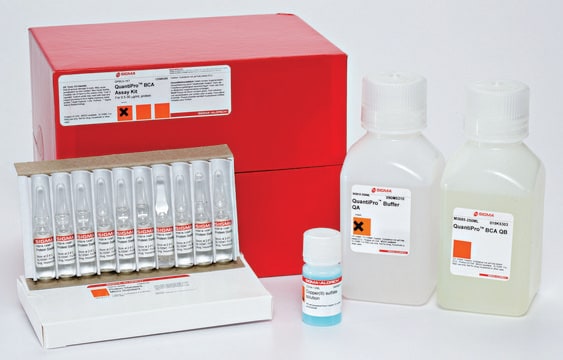R1137
Hind III from Haemophilus influenzae
Restriction Enzyme
Sign Into View Organizational & Contract Pricing
All Photos(1)
About This Item
CAS Number:
MDL number:
UNSPSC Code:
12352204
Recommended Products
grade
for molecular biology
form
buffered aqueous glycerol solution
concentration
≥10000 units/mL
10,000 units/mL
shipped in
wet ice
storage temp.
−20°C
Looking for similar products? Visit Product Comparison Guide
Specificity
Recognition sequence: 5′-A/AGCTT-3′
Cutting results: 2-10-fold Hind III overdigestion of 1 μg λ DNA substrate results in 100% cutting
Heat inactivation: 65 °C for 15 minutes
Cutting results: 2-10-fold Hind III overdigestion of 1 μg λ DNA substrate results in 100% cutting
Heat inactivation: 65 °C for 15 minutes
Application
HindIII, a restriction endonuclease, is used in molecular biology applications to cleave DNA at the recognition site 5′-A/AGCTT-3′ to generate DNA fragments with cohesive 5′-ends.
Other Notes
Supplied with 10x Restriction Enzyme Buffer SB (B8781)
Comment: Hind III under suboptimal reaction conditions will cleave secondary recognition sites (star activity).
Physical form
Solution in 10 mM Tris-HCl, pH 7.5, 0.1 mM EDTA, 1 mM dithioerythritol, 250 mM NaCl, 0.01% polydocanol (v/v), 50% glycerol (v/v) at 4 °C
Incubation buffer
Product No.
Description
Pricing
Related product
Storage Class
12 - Non Combustible Liquids
wgk_germany
WGK 1
flash_point_f
Not applicable
flash_point_c
Not applicable
Certificates of Analysis (COA)
Search for Certificates of Analysis (COA) by entering the products Lot/Batch Number. Lot and Batch Numbers can be found on a product’s label following the words ‘Lot’ or ‘Batch’.
Already Own This Product?
Find documentation for the products that you have recently purchased in the Document Library.
Stephen J King et al.
Molecular biology of the cell, 14(12), 5089-5097 (2003-10-21)
Cytoplasmic dynein and dynactin are megadalton-sized multisubunit molecules that function together as a cytoskeletal motor. In the present study, we explore the mechanism of dynein-dynactin binding in vitro and then extend our findings to an in vivo context. Solution binding
Tomás Brdicka et al.
The Journal of experimental medicine, 196(12), 1617-1626 (2002-12-18)
A key molecule necessary for activation of T lymphocytes through their antigen-specific T cell receptor (TCR) is the transmembrane adaptor protein LAT (linker for activation of T cells). Upon TCR engagement, LAT becomes rapidly tyrosine phosphorylated and then serves as
M Hsu et al.
Biochemistry, 17(1), 131-138 (1978-01-10)
In the presence of 100 mM Tris buffer (pH 7.5) and 1-10 mM Mg2+ EcoRI endonuclease cleaves DNA at a specific nucleotide sequence and in a characteristic way: -GAATTC-. But if Mg2+ is replaced by Mn2+, the specificity of the
Jaroslav Jelinek et al.
Epigenetics, 7(12), 1368-1378 (2012-10-19)
Genome wide analysis of DNA methylation provides important information in a variety of diseases, including cancer. Here, we describe a simple method, Digital Restriction Enzyme Analysis of Methylation (DREAM), based on next generation sequencing analysis of methylation-specific signatures created by
Saqib H Ansari et al.
Journal of pediatric hematology/oncology, 35(4), e153-e156 (2013-02-08)
β-thalassemia is characterized by impaired β-chain synthesis leading to ineffective erythropoiesis, severe anemia, and a need for blood transfusion. Presence of Xmn I polymorphism (-158 C-T nucleotide change) in γ-globin gene is associated with a higher fetal hemoglobin and a
Our team of scientists has experience in all areas of research including Life Science, Material Science, Chemical Synthesis, Chromatography, Analytical and many others.
Contact Technical Service







